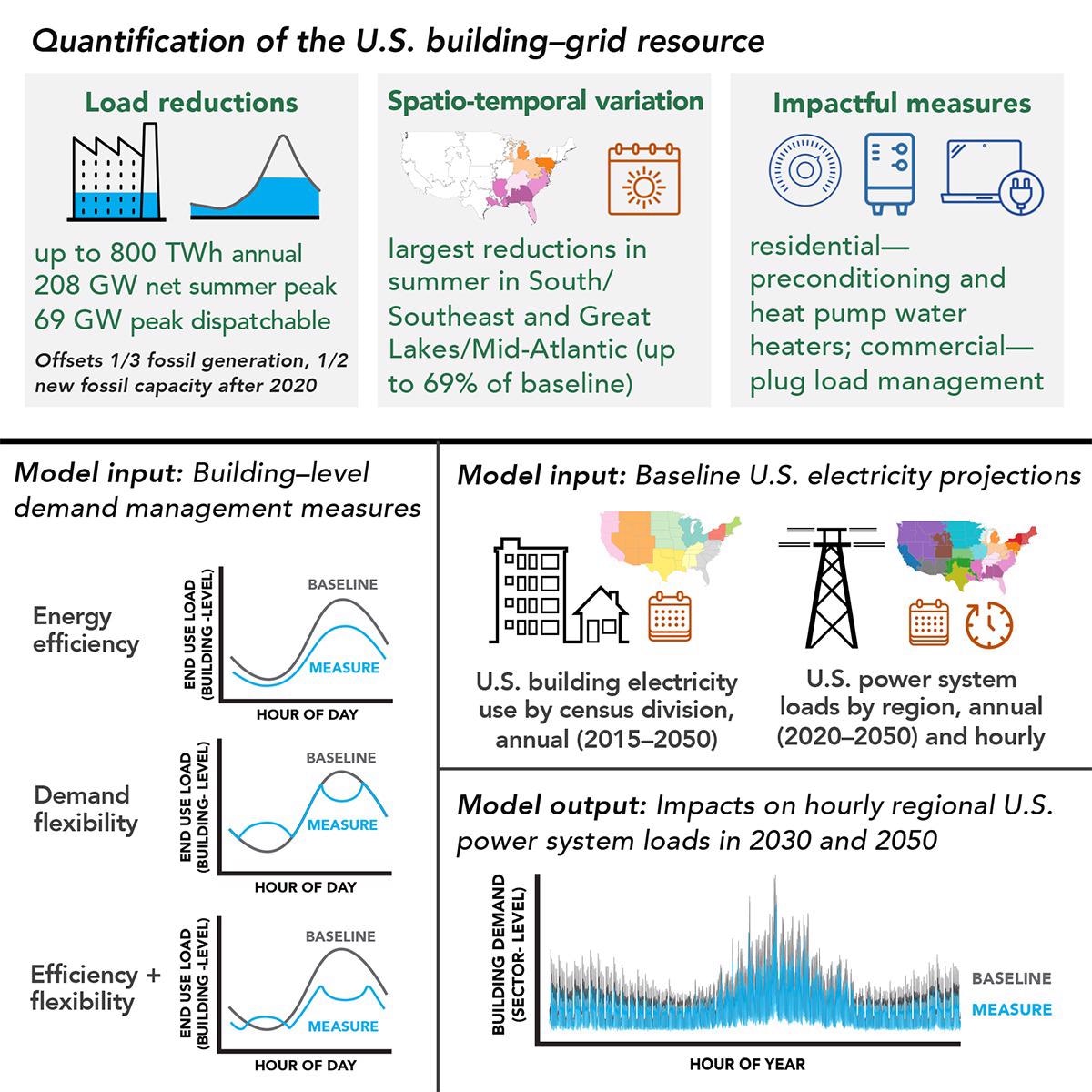In the United States, buildings consume about 75% of the electricity, which implies that they have a huge ability to save energy and decrease the demand on the swiftly changing electric grid. However, the quantity, method, location and strategy by which this energy use can be better managed are still questionable.
 Deploying certain technologies to manage energy demand in buildings has the potential to avoid the need for up to one-third of coal- or gas-fired power generation, according to a new study led by Berkeley Lab. Image Credit: Berkeley Lab.
Deploying certain technologies to manage energy demand in buildings has the potential to avoid the need for up to one-third of coal- or gas-fired power generation, according to a new study led by Berkeley Lab. Image Credit: Berkeley Lab.
A new, detailed study led by scientists from the Department of Energy’s Lawrence Berkeley National Laboratory (Berkeley Lab) resolved these questions and explained the action required to make buildings more energy-efficient and flexible in granular detail by both space (looking at regions across the United States) and time (including time of day and year).
The team also included researchers from the National Renewable Energy Laboratory (NREL). They observed that optimizing the deployment of building demand management technologies is capable of avoiding the requirement of up to one-third of coal- or gas-fired power generation and implies that at least half of all such power plants predicted to be brought online between now and 2050 would not have to be built.
The study was recently published in the journal Joule.
A key reason why we don’t hear more about the role of our buildings as a significant resource for the clean energy transition is because it’s been challenging to quantify that resource at a large scale — and without hard numbers at scale, it’s hard for policy makers or grid operators to plan around it.
Jared Langevin, Study Lead Author, and Researcher, Berkeley Lab
“Our overarching belief here was that producing these kinds of estimates that make the role of these demand-side building technologies more concrete will help ensure that we do more to encourage the deployment of those technologies alongside the deployment of renewable generation and batteries,” added Langevin.
We’re excited to collaborate with Berkeley Lab on these research findings, which emphasize the impact of our nation’s buildings to achieve a decarbonized energy system.
Achilles Karagiozis, Director, Building Technologies and Science Center, National Renewable Energy Laboratory
The electricity consumed in homes and workplaces for operating equipment like water heaters, air conditioning, lights, and other appliances is referred to as the demand-side of electricity.
The researchers took this electricity use from buildings as a grid source. They found that improving the efficiency and flexibility of electricity use in buildings, for example, by operating high-performance equipment and shifting the time when it is used, this resource is significant, eliminating the need for up to 742 terawatt-hours (TWh) of annual electricity use and 181 gigawatts (GW) of daily net peak load in 2030, increasing to 800 TWh and 208 GW by 2050.
The team noted that the most influencing measures for residential buildings were pre-conditioning (where homes are pre-cooled to decrease air-conditioning usage at peak times) and the use of heat pump water heaters. In the case of commercial buildings, plug load management, which involves using software to regulate the electricity usage of computers and other electronic devices in a building, was the most influential.
Our initial estimates suggest tens of billions of dollars in annual cost savings potential for grid operators—not to mention the potential energy cost savings for families and businesses. Buildings are also a significant source of flexibility for grid operators, primarily in dialing down electricity demand during times when it would normally be at its peak, such as during really hot summer days when most air conditioners are running.
Achilles Karagiozis, Director, Building Technologies and Science Center, National Renewable Energy Laboratory
According to Langevin, reducing the peak demand can result in lowering the requirement for battery technologies as they will deploy more renewable energy.
“Indeed, the flexible resource we found is comparable to higher-end projections of battery deployment needs under higher renewable energy deployment,” added Langevin.
Texas, the Great Lakes, Mid-Atlantic regions, and the Southeast were observed as regions with buildings having the potential to provide the largest grid resource.
“These are areas with high population, strong space conditioning needs, and lots of electric equipment already installed. This information at the regional scale is really important for developing tangible policies for realizing the resource that we’re reporting,” stated Langevin.
The approaches to tap the potential building-grid resource identified by the study are already under development. For example, the DOE came up with a National Roadmap for Grid-Interactive Efficient Buildings, which is based on the findings of the study and offers strong recommendations for tripling the efficiency and flexibility of the buildings sector by 2030.
“Continued efforts along these lines will be critical for establishing a key role for the buildings sector in the future evolution of the U.S. electricity system. Our findings are encouraging, but now we need to find ways of quickly putting this resource into practice,” concluded Langevin.
The research was financially supported by the Building Technologies Office under DOE’s Office of Energy Efficiency and Renewable Energy.
Journal Reference:
Langevin, J., et al. (2021) US building energy efficiency and flexibility as an electric grid resource. Joule. doi.org/10.1016/j.joule.2021.06.002.